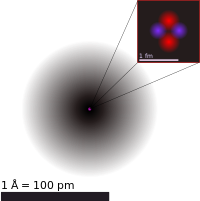
Photo from wikipedia
Electron-phonon (e-ph) interaction in semiconductors is responsible for many phenomena such as electron mobility and hot electron thermalization, which are important to compute charge transport in semiconductors. In semiconductors, the… Click to show full abstract
Electron-phonon (e-ph) interaction in semiconductors is responsible for many phenomena such as electron mobility and hot electron thermalization, which are important to compute charge transport in semiconductors. In semiconductors, the application of hydrostatic pressure modifies the character of conduction band valleys, changing the effective mass of carriers, and, consequently, changing the carrier mobility. This, in turn, may limit electron transport in the semiconductor. Here, we present the effect of hydrostatic pressure on the e-ph interaction in GaAs, which goes from a direct to an indirect bandgap semiconductor at high pressures. A detailed study of e-ph self-energy and the resulting scattering rates is presented for hydrostatic pressure ranging between 0 and 9.2 GPa. Individual contributions from phonon modes to the total scattering rates indicate that short wavelength LO phonon scattering is found to be the dominant mechanism at low pressures; and at higher pressures, acoustic as well as optic phonons contribute toward the overall e-ph scattering. Finally, relaxation times are evaluated and we find that at pressures above 2.9 GPa, electron relaxation times are an order of magnitude lower than at equilibrium. These results will influence transport properties at higher pressures.Electron-phonon (e-ph) interaction in semiconductors is responsible for many phenomena such as electron mobility and hot electron thermalization, which are important to compute charge transport in semiconductors. In semiconductors, the application of hydrostatic pressure modifies the character of conduction band valleys, changing the effective mass of carriers, and, consequently, changing the carrier mobility. This, in turn, may limit electron transport in the semiconductor. Here, we present the effect of hydrostatic pressure on the e-ph interaction in GaAs, which goes from a direct to an indirect bandgap semiconductor at high pressures. A detailed study of e-ph self-energy and the resulting scattering rates is presented for hydrostatic pressure ranging between 0 and 9.2 GPa. Individual contributions from phonon modes to the total scattering rates indicate that short wavelength LO phonon scattering is found to be the dominant mechanism at low pressures; and at higher pressures, acoustic as well as optic p...
Journal Title: Journal of Applied Physics
Year Published: 2019
Link to full text (if available)
Share on Social Media: Sign Up to like & get
recommendations!